Peugeot
![]()
This article is about the French car manufacturer. For other meanings see Peugeot (disambiguation).
Peugeot [pøˈʒo] is a French vehicle manufacturer and, with the start of series production in 1891, the oldest car brand still in existence. Peugeot was initially part of Groupe PSA. After the merger of PSA and FCA, Peugeot represents one of the brands in the newly formed Stellantis Group.
In addition to motor vehicles, Peugeot also produces bicycles, do-it-yourself machines, grinders for the construction industry and spice mills. Motorcycle production, now Peugeot Motocycles, was spun off into a separate company as early as 1926.
Peugeot's main plant is the factory in Sochaux, which opened in 1912. Other French sites are Mulhouse, Poissy and Rennes. Peugeot is active abroad in Portugal (Mangualde), Spain (Madrid and Vigo), Slovakia (Trnava), the Czech Republic (Kolín) and Argentina (El Palomar near Buenos Aires and together with FIAT in Córdoba).
The English plant Ryton-on-Dunsmore, taken over by Chrysler United Kingdom in 1979, where Peugeot built the type 206 from 1998, was closed at the end of 2006 and production of the successor type 207 continued in Trnava (Slovakia).
Peugeot's German headquarters were based in Saarbrücken from 1936 until the end of 2012. In 1967, Peugeot Deutschland GmbH was founded. In 2013, the headquarters were moved to Cologne and merged with the sister brand Citroën. Following the takeover of Opel by parent company PSA, the German headquarters of PSA, Peugeot, Citroën and DS moved to Rüsselsheim in 2019.
Since production began in 1891, over 50 million vehicles have been manufactured worldwide. The 50 millionth Peugeot was a 308 SW. Across Europe, Peugeot models are among the best-selling passenger cars. In 2007, 1.786 million Peugeot vehicles were sold, an increase of 3.7% over the previous year. In 2008, global sales totaled 1.904 million vehicles; after a sales low of 1,842,000 vehicles in 2009, the number rose to 2,142,000 units in 2010. In 2012, Peugeot sold 1,700,000 units and 1,552,700 vehicles the following year.
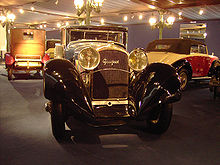
A 1920s Peugeot in the Musée National de l'Automobile in Mulhouse
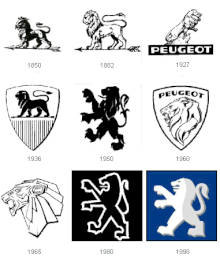
Some former company logos
Company History
Origins
The name-giving founding family Peugeot comes from the surroundings of Montbéliard and is of Protestant denomination. Since Montbéliard and the surrounding area were under Württemberg rule from 1397 to 1796 as the county of Montbéliard (German: Grafschaft Mömpelgard), some jokingly count the Peugeot brand as one of the "Swabian car brands" (alongside Daimler-Benz, Porsche, NSU).
The Peugeots first appeared as entrepreneurs at the end of the 18th century with an oil mill, tannery and dye works in Hérimoncourt. They later added a spinning mill, and a second one was opened in Audincourt on the Doubs.
In 1810, the year Peugeot was founded, the brothers Jean-Frédéric and Jean-Pierre Peugeot set up an iron foundry on the site of the oil mill in Herimoncourt in response to changing economic circumstances. From 1819, rolling irons, saw blades, watch springs and corset stays were made there from steel strips. Other factories for tools and ironmongery were set up at Valentigney and, from 1857, at Beaulieu - now Mandeure.
·
Peugeot coffee grinders and sewing machine advertising
· 
Peugeot emblem on a 19th century sewing machine
In the second half of the 19th century, the Peugeot product range, which also included mechanical shearing machines, springs for phonographs, agricultural implements, razor blades, coffee grinders and irons, was known far beyond the borders of France because of its quality. To this day, Peugeot still produces tools, pepper and coffee grinders in addition to vehicles.
The "official birth of the lion" is considered to be 20 November 1858, the date on which the Peugeot lion (→ Logo section) was registered as a trademark for Peugeot products.
The good earnings situation also benefited the workforce from the middle of the century onwards. Remarkable for that time are social institutions such as the mutual aid fund (1853), the foundation of a workers' hospital (1870), the ten-hour working day (1871) and the annual pension for factory employees (1876). Finally, housing was also built for the staff.
In 1896, Armand Peugeot founded the Société Anonyme des Automobiles Peugeot, with headquarters in Audincourt and Lille.
In the last quarter of the 19th century, Peugeot recognized the signs of the times and turned more and more to vehicle construction, which is still the main focus of the company's activities today.
· 
Peugeot 201, 1924
· 
Peugeot 403, 1955
· .jpg)
Peugeot 404, 1965
Logo
As the saw teeth of the Peugeot saw blade production (from 1819) were reminiscent of the jaws of a lion, the lion became Peugeot's distinguishing mark. In 1858, the lion was registered as a trademark, which was designed by a local goldsmith named Justin Blazer. The lion as a logo symbolizes the three qualities of the saw blades: their robustness, the elasticity of the blades and the fast cutting. From 1906, the lion adorned the radiator grilles. It was used as a radiator figure until 1958. With the 1959 model year, this was abolished, as it represented a potential danger to pedestrians and cyclists.
Over the years, the logo has been modified several times. The posture or position of the lion on the various logos also varies. On the pepper mills he stands on four legs, on the bicycles he sits upright. On the cars, he stands upright on his hind legs with his paws raised (as shown). These three logos are still in current use.
From 1948 and the 203, the Franche-Comté coat of arms was used as the logo, as a sign of the company's attachment to its home region. Since then, all logo versions of Peugeot cars have been derived from this coat of arms.
In February 2021, Peugeot unveiled a new logo inspired by that of the 1960s, featuring only the lion's head in an escutcheon.
· 
Peugeot radiator mascot
· 
Peugeot radiator mascot
· 
Radiator grille of a Peugeot 203 A
· 
The lion on a Peugeot 205
·
The lion on an old Peugeot securities paper
Pepper mills
Pepper mills with the famous Peugeot grinder are a proven Peugeot product. They have been manufactured since 1842 and are thus the oldest products of the group. This part of the company operates under the name Peugeot Saveurs.
Bicycle construction
→ Main article: Peugeot (bicycles)
In 1881, Peugeot began manufacturing bicycles, the importance of which Armand Peugeot had recognized during a stay in England. Under the name "Le Français", the "Fils de Peugeot frères" presented a high-wheel bicycle in 1882.
In 1888, Peugeot had established itself on the market with its bicycle models. Now the factory in Beaulieu (today incorporated in Mandeure) near Valentigney also began manufacturing bicycles. The brand name Lion was chosen in reference to the company symbol.
In the bicycle segment, Peugeot (according to old custom, but also from close observation of the market) focused on a wide range of products. Tandems, even quads and fives, appeared in the catalogues of the time. In 1899, a four-wheeler with two seats was presented as a "bicyclette sans chaîne" (bicycle without chain). A low-maintenance cardan drive took over the power transmission to the rear wheel, a technology that would not become established even on motorcycles until decades later.
Another innovation was a folding bike that could be folded and taken into the home to prevent theft. Its frame design also allowed it to be adjusted to different body sizes. Both the axle distance and the distance of the saddle from the pedals and handlebars could be varied. Two independent brakes guaranteed active safety, and a hoof nail extractor was intended to protect against punctures.
In 1906, Peugeot bicycles were the first to be fitted with a two-speed hub gear.
· 
Peugeot folding bike
· 
Racing bike of the 1980s
·
New models, Motorshow Geneva 2012
Automobile construction
In 1889, Armand Peugeot had the first motor vehicle built, the so-called Serpollet tricycle; a vehicle powered by steam, which today would be called a "prototype". It was not until the change to Type 2 that the switch to internal combustion engines was made, although these came from the Daimler-Motoren-Gesellschaft. In 1896, a Peugeot was registered in Vienna as the first mass-produced petrol engine car. The year 1898 is regarded as the beginning of the brand's global success. As early as 1900, 500 vehicles and 20,000 bicycles were produced. Until 1910 there were still two competing Peugeot brands: Automobiles Peugeot with plants in Audincourt and Lille, and Lion-Peugeot in Beaulieu (now a district of Mandeure) near Montbéliard. The two companies then merged to form the Société des Automobiles et Cycles Peugeot.
In 1912, another plant was built in Sochaux. Originally, trucks were produced here. In 1917, mass production of series vehicles began at this plant. In 1925, the Sochaux plant became the headquarters for passenger car production. Due to the First World War and general mobilization, many factories, including Peugeot, were forced to use their facilities for war purposes, which meant that no new projects were undertaken.
In 1929, the Model 201 was presented at the Paris Motor Show. This model, which was produced a total of 140,000 times until 1936, proved to be particularly successful, gave Peugeot a better financial situation and contributed significantly to its good reputation as a car manufacturer. The 201 was the first car to feature the later patented middle zero in the model designation, which remains to this day. Also in 1929, the diesel engine and the sunroof were introduced for the cars.
After the Second World War, reconstruction began by restructuring the technical equipment and mechanical systems. The new 203 model became an immediate success from 1948. In 1955, the 403 was introduced, the first mass-produced Peugeot available with a diesel engine. The 403 is the first Peugeot designed by the Italian designer Pininfarina.
Introduced in 1960, the 404 model was a great success throughout Europe as well as in the French-speaking part of Africa. The 404 was particularly popular as a taxi vehicle in these countries. Peugeot's steady expansion led to the creation of the holding company Peugeot S.A. in 1965, which controlled the various companies in the group. In the same year, the Mulhouse plant was built.
In 1974, Peugeot became the majority shareholder in Citroën. Two years later, the merger of the two companies created Groupe PSA. In 1978 PSA bought the European subsidiaries of Chrysler with the brands Chrysler-Simca, Simca, Sunbeam and Matra-Simca. As the name Chrysler was no longer allowed to be used, the new subsidiary was first to be given back the name Simca, but marketing experts advised against this, as the brand was too closely associated with Chrysler. So from 1979 onwards, the brand name of the new subsidiary was Talbot, a small manufacturer that had been taken over by Simca in 1959.
As the takeover of Talbot proved to be very difficult and costly, the sales and administration of Peugeot and Talbot were merged in 1980. Until the appearance of the Peugeot 205 in 1983, the PSA group continued to be in the red, helped by strikes, especially at Talbot and Citröen. With the appearance of the Peugeot 205 Peugeot went uphill again, only Talbot went further downhill and finally the brand was given up in 1986. The already finished successor of the Talbot Horizon, originally planned as Talbot Arizona, was then unscheduledly brought to the market in 1985 as Peugeot 309.
Motorcycle construction
Peugeot was the most important French motorcycle manufacturer by number of units.
From 1899 onwards, motorised two-wheelers were produced with 1.5 hp Zedel engines from Switzerland, which still had to make do without a clutch and gearbox. From 1902 Peugeot built full-fledged motorcycles, initially with 2 hp engines from Zedel, from 1903 with self-developed 2.5 and 2.75 hp four-stroke engines with 238 and 333 cm³ displacement respectively. A sprung front fork was available at extra cost. From 1905 Peugeot also offered two-cylinder engines of varying power, with displacements of 350 to 1000 cm³ and outputs of 2.75 to 7 hp.
Even before the First World War, Peugeot developed into a successful supplier of built-in engines throughout Europe, also for English motorcycle manufacturers such as Norton. In 1907 Rem Fowler won the first Tourist Trophy on the Isle of Man in the two-cylinder class on a Norton equipped with a Peugeot engine. In 1909, Peugeot entered its own racing machines in the Tourist Trophy and went on to win numerous major European and American races.
In 1913, Peugeot made a name for itself at the Paris-Nice long-distance race with a two-cylinder racing engine, the Peugeot 500 Sport, which had a displacement of 500 cm³, two overhead camshafts and four valves per cylinder. This made speeds of over 120 km/h possible, but the engine was thermally unstable, which is why the design was not developed further.
The First World War brought Peugeot's civilian motorcycle production to a standstill. Military machines with side-controlled two-cylinder engines and 750 cm³ displacement were now built in particular. After the war, the company continued its old traditions and returned to prestigious racing. In 1923, Peugeot racing machines with a two-cylinder engine newly developed by engineer Lessman Antoinesco produced up to 27 hp with a displacement of 500 cm³ and reached top speeds of over 160 km/h.
The 1920s were also marked by the production of lightweight machines suitable for everyday use, which were equipped with a 250 cc two-stroke engine that produced 3.5 hp, a two-speed gearbox and a sprung front fork. The Cyclo-Moto, which had an engine integrated into the front wheel hub, remained a curiosity.
In 1925, a 175 cc two-stroke block engine was introduced for the first time, i.e. a power unit whose gearbox was no longer mounted separately but was located in a common housing with the actual drive. A centre stand was introduced at the same time, which together with trapezoidal front forks and drum brakes rounded off the advanced concept.
In 1926, the automobile and motorcycle divisions at Peugeot separated and official racing was abandoned. In the same year, the block engine concept was transferred to the four-stroke, the machines equipped with it founded the type series "P", which was to continue until the 1950s. The models P 101, 102, 103 and 104 were followed from 1927 by the head-controlled top model P 105 with 350 cm³ and its side-controlled smaller sister models P 107, 108, 109 and 110. In addition, unpretentious two-strokes with up to 175 cm³ continued to be built. The P 50 model with a 98 cc engine could be ridden without a driving licence.
In 1930 Peugeot experienced a fiasco with the P 111, which was equipped with a fork made of pressed steel for cost reasons. The design was not torsionally stiff, made for unsafe handling and was quickly dropped. In 1933 Peugeot introduced a new generation of block engines, which had displacements of 350 to 500 cc and side- or head-valves. With the top model P 515, speeds of up to 140 km/h were possible.
From 1938 onwards, Peugeot - like many other motorcycle manufacturers - had to contend with sales problems despite a product range tailored to a wide range of customer needs. From then on - until the end of motorcycle production in 1959 - Peugeot concentrated on the manufacture of relatively simple machines with displacements between 98 and 175 cc, suitable for mass motorisation.
In 1939, the P 53 was introduced, which had a 100 cc two-stroke engine with three-speed gearbox and was available in various equipment variants. This laid the foundation for a series of uncomplicated and reliable two-wheelers built until the end of the 1950s, which had the appearance of fully-fledged motorcycles with modest performance and enjoyed great popularity in their home country. However, they were never able to gain a foothold on the German market, which was dominated by strong brands (Adler, DKW, NSU, Zündapp) even in the lower displacement classes.
The Second World War and the occupation of France by the German Wehrmacht interrupted the development and production of civilian motorcycles at Peugeot.
At the end of 1944 Peugeot announced the production of the P 54, an improved successor to the P 53 developed before the war. The P 54 still had a 100 cc two-stroke engine with 3-speed gearbox, but now offered a luggage rack, a more elaborate saddle suspension and a tank more reminiscent of motorcycles. The front wheel was still suspended via a trapezoidal fork, rear suspension was still not available.
In 1946 the P 55 appeared, whose basic construction corresponded to the P 54, which was however equipped with a 125 cm³ two-stroke engine.
The P 55 gave rise to a large number of equipment and performance variants in the years up to the end of motorcycle production in 1959. In contrast to the P 55, the P 56 had a four-speed gearbox with the same displacement, the P 155 had a 150 cc engine (with four-speed gearbox: P 156), the P 255 had a 250 cc engine (with four-speed gearbox: P 256) and the P 356, which appeared in 1957, had a 350 cc engine with two cylinders and four-speed gearbox. There were also versions with telescopic forks, rear suspension, elaborate chrome plating, additional fairing parts and other special features. However, the classic appearance of the original P 55 design was gradually lost. Compared to German competitors, the early 125 cc Type 55 machines in particular stand out due to their particularly successful proportions and elegant colour scheme (various shades of beige, grey and brown, some with multi-coloured paintwork, some with lines). For collectors of classic French motorcycles, they are certainly the most attractive post-war models from Peugeot.
Once again there was a sports motorcycle in Peugeot's post-war range, the 176 GS, based on the 176 TC4 released in 1951. This model did extremely well in amateur racing in the 1952 season, which is why Peugeot decided to enter it in the Bol d'Or. André Bouin took a commanding class victory and fifth place overall. This is why Peugeot fans always refer to the 176 GS presented at the end of 1952 simply as the "Bol d'Or".
The most successful moped produced by Peugeot was the "BB", which was built in various model variants from 1957 to 1970. The 50 cc single-cylinder engine had a power output of 1.35 kW (1.85 hp) and produced a top speed of up to 55 km/h.
In 1959, Peugeot stopped building motorcycles. Since then, only mopeds and scooters have been produced under the traditional brand.
.jpg)
Cyclomoteur Peugeot "BB" (1957)
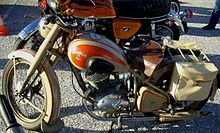
Peugeot type 176-TC4 with 175 cm³ (1952)

Peugeot P 111 with 327 cm³ (1931)

Peugeot motorcycle with 220 cc engine (1907)

Peugeot 403 Cabriolet (known from the TV series Columbo)

Peugeot Type 19 (1899)
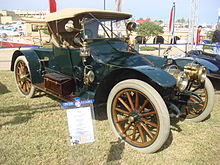
Peugeot Type 139A Phaeton (1913)

Peugeot 601 C Eclipse Pourtout (1934)

Peugeot 6 HP Vis-à-vis (1898)
Motorsports
Rally
Peugeot is particularly involved in rally sport. There, for example, the 205, 306, 307 and the 206 were able to celebrate successes.
As early as the 1960s, Peugeot won a wide variety of rallies with the 404, including the "East African Safari" several times. In 1984, the year of the first participation in the World Rally Championship with the Peugeot 205 T16, the Finn Ari Vatanen demonstrated the potential with his temporary lead on Corsica. Barely three months later, the first victory of a special stage was achieved at the 1000 Lakes Rally in Finland, followed by further successes at the Sardinia and Wales rallies.
In the following two years, Peugeot dominated the World Rally Championship despite very strong opponents. The two Finns Timo Salonen and Juha Kankkunen became world champions in succession on Peugeot in 1985 and 1986, the one-make world championship title also went to Paris. Audi was thus ousted from the winners' podium.
At the RAC Rally at the end of 1985, the second edition of the Peugeot 205 T16 was presented with the factory designation Evolution 2. It was, to be ahead against the growing competition from Audi, Lancia and Ford, given a sophisticated wing program and the turbo boost pressure was increased to 2.5 bar. Now an output of 315 kW (430 hp) at 7500 rpm had been achieved.
After Group B was banned in the mid-1980s, Peugeot continued to turn its rally experience into successes, not only in the hill climb at Pikes Peak, but above all in the Dakar Raid Rally with the two models 205 and 405. Here, too, the Finn Ari Vatanen was able to write his name into the annals of Peugeot motorsport history. Peugeot won the Dakar Rally in 1987-1990, and in 2015 Peugeot again took part in the Dakar Rally.
Peugeot returned to the top of rallying in 1999 with the introduction of the 206 WRC. With the Finnish driver Marcus Grönholm, the driver's world championship was won in 2000 and 2002, from 2000 to 2002 also three times in a row the title for the best constructor. The 206 WRC's successor was the Peugeot 307 WRC (based on the coupé convertible version), which was used up to and including 2006; however, the Peugeot works team then withdrew from the World Championship. In the following years, however, Peugeot continued to compete in subordinate series such as the Intercontinental Rally Challenge or the European Rally Championship, using rally versions of the 207 and 208 models.
Sports Car Racing
At the end of the 1980s, Peugeot also established itself in the field of sports car racing with the 905. The 905 won the 24 Hours of Le Mans in 1992 and 1993, as well as the 1992 World Sports Car Championship. After the FIA discontinued the World Sports Car Championship in 1993, Peugeot withdrew from this segment for the time being. However, it continued to provide engines to the French racing team of Gérard Welter and Henri Pescarolo until the manufacturer returned to Le Mans itself in 2007 with a Le Mans prototype. However, the Peugeot 908 HDi FAP diesel race car lost the 2007 and 2008 races to Audi's established squad. This initially left the factory with victory in the 2007 Le Mans Series, but on 14 June 2009, Team Peugeot Sport Total took a one-two in the 24 Hours of Le Mans. In the following two years, Peugeot again lost to Audi, but secured the Intercontinental Le Mans Cup with eight wins in ten races. In 2012, despite having begun preparations for the season, the factory team withdrew at short notice. The difficult economic situation was cited as the reason.
Touring car racing
There were also entries in touring car racing: Peugeot cars were successful with drivers' titles in the Championnat de France de Supertourisme (1994, 1999-2000, 2002, 2004-2005), Danish Touringcar Championship (1999-2003), Asian Touring Car Series (2000-2002) and Stock Car Brasil (2008-2009, 2012) racing series, as well as the short-lived German Super Touring Car Cup (1997), among others. In contrast, the more prominent British Touring Car Championship, in which Peugeot fielded a works team from 1992 to 1998 and 2001, did not see sustained success. However, the prestigious 24 Hours of Spa-Francorchamps was won twice in more recent times (1999, 2000) after an early victory in 1926.
Formula 1
From 1994 to 2000, Peugeot was active as an engine supplier for various Formula 1 teams. The Formula 1 involvement was linked to the Group C sports car project, especially as the engine regulations in the final years of the World Sports Car Championship were practically identical to those of Formula 1. Consequently, the Formula 1 engines developed by Peugeot were based on those of the Peugeot 905. However, the successes of McLaren, Jordan and Prost did not materialize: Although the McLaren and Jordan drivers in particular achieved a number of podium finishes, the Peugeot engines acquired a very unreliable reputation with numerous defects, and the French manufacturer withdrew. At the end of 2000, the Formula 1 engines were sold to the Asiatech company, which used them under its own name, but without technical modifications, at Arrows in 2001 and at Minardi in 2002.
Other
It is less known that Peugeot cars won the Indianapolis 500 three times (in 1913 by Jules Goux, in 1916 by Dario Resta and in 1919 by Howard Wilcox).
And also that on 27 April 2011, the Peugeot EX1 with electric drive lapped the 20.8 km Nürburgring-Nordschleife in 9:01.338 min.
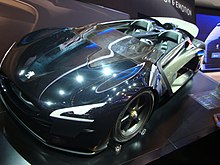
Electric sports car Peugeot EX1

Mika Häkkinen on McLaren-Peugeot. Silverstone, 10 July 1994
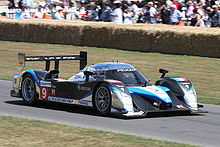
Peugeot 908 HDi FAP at the presentation in Goodwood 2009

Peugeot 905 B
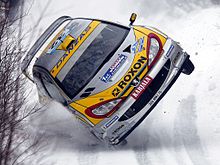
A Peugeot 206 WRC at the Rally Sweden 2003 on snow
Search within the encyclopedia


